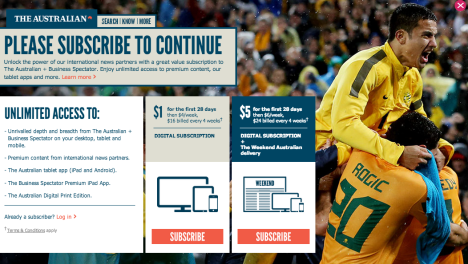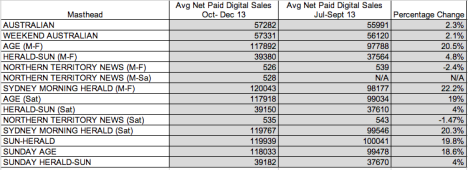Digital sales growth slowing for Australian newspapers
Growth of paying digital subscribers for Australia’s major newspapers may be losing steam, new audit numbers published today suggest.
The newspaper which has seen the most consistent reduction in growth of digital sales is The Australian, published by News Corp. Its overall digital sales grew by just 2.3 per cent compared to the prior quarter.
The newspaper industry is likely to point towards seasonal variations as a factor, with the three months to December usually a slower sales time for newspapers.
However, The Australian’s digital growth also slowed in previous quarters – from an uplift of 16% in the first quarter of last year, to +5.3% in the second quarter and +4.8% in the third.
The performance of print circulations are usually best compared year-on-year to cut seasonal variations out of wider trends. But in this case Mumbrella has chosen to make quarter-by-quarter comparisons because the relatively recent arrivals of paywalls means there are not yet long term trends.
The Australian – which was the first major Aussie masthead to launch a paywall in October 2011 – now has 57,282 digital subscribers.
The Australian M-F digital sales
- December 2012 – 39,539
- March 2013 – 45,869 (+16%)
- June 2013 – 51,213 (+5.3%)
- September 2013 – 55,991 (+4.8%)
- December 2013 – 57,282 (+2.3%)
 The Audited Media Association of Australia rules allow publishers to include in their digital figures digital subscriptions and packages that include both print and digital.
The Audited Media Association of Australia rules allow publishers to include in their digital figures digital subscriptions and packages that include both print and digital.
A full digital-only subscription to The Australian costs $4 per week, suggesting the newspaper’s digital-only sales are at best bringing in $230,000 per week and probably much less. If replicated across other newspapers, this figure suggests that digital sales are a long way from making up for the shortfall in print revenues.
Members of the AMAA are not yet obliged to share their digital data, although once they start they must continue to do so.
News Corp publishes digital numbers for its Melbourne tabloid the Herald Sun which also has a pay wall. But it does not share digital numbers for Sydney title The Daily Telegraph or The Courier Mail in Brisbane.
The Herald Sun has also seen a slowing of its digital sales growth since its paywall launched last March. Its first three months with a paywall saw a 27.5% growth in digital sales, albeit off the relatively low base of 33,714. In the latest quarter, it saw sales grow by just 4.8 per cent.
Herald Sun M-F digital sales
- March 2013 – 26,436 (First publication of data)
- June 2013 – 33,714 (+27.5%; after paywall launch)
- September 2013 – 37,564 (+11.4%)
- December 2013 – 39,380 (+4.8%)
Digital-only subscriptions to The Herald Sun are priced at $4 per week, suggesting digital-only weekly revenues of about $150,000 at best, and probably much less.
Fairfax Media’s major two metro titles – The Sydney Morning Herald and The Age – also saw a slowdown in their digital sales growth in the last quarter.
This came after both saw initial jumps in digital sales following the launch of metered paywalls in July. Both titles overtook The Australian in the quarter up to September 2013.
The Age M-F digital sales
- Dec 2012 – 37,162
- March 2013 – 41,381 (+11.4%)
- June 2013 – 47,951 (+13.7%)
- September 2013 – 97,788 (+51%; after paywall launch)
- December 2013 – 117,892 (+20.6%)
Sydney Morning Herald M-F digital sales
- December 2012 – 37,162
- March 2013 – 44,697 (+20.3%)
- June 2013 – 43,191 (-3.5%)
- September 2013 – 98,177 (+127.3%; after paywall launch)
- December 2013 – 120,043 (+22.3%)
The Age and The SMH’s most expensive digital subscriptions are around $6 per week, suggesting they could together be bringing in Fairfax Media about $1.4m per week at best. However, the actual total is likely to be much lower as website access is priced lower, and The Age’s and SMH’s digital subscriptions have been boosted by school and tertiary education sales which are at a lower price.

Metro and national titles’ digital sales (in most cases Sunday subscribers are also weekday susbcribers as part of the same package)
Meanwhile, the magazine recording the highest digital figure was News Corp’s Donna Hay, with sales of 13,631. This was followed by Bauer Media’s Australian Women’s Weekly on 9,600.
Tim Burrowes



 Linkedin
Linkedin
this is unfair
to illustrate your newspaper print decline you use YOY numbers (https://mumbrella.com.au/abcs-age-tops-list-circ-falls-17-per-cent-decline-print-continue-double-digit-declines-206476)
to illustrate your newspaper digital flattening you use QOQ numbers …
you can’t have it both ways.
Digital newspaper YOY are all up – compare Dec period 2012 with Dec period 2013 like you have for the print product.
User ID not verified.
Hi Shamma,
Usually, I’d agree. So I did address that point in the article:
“The performance of print circulations are usually best compared year-on-year to cut seasonal variations out of wider trends. But in this case Mumbrella has chosen to make quarter-by-quarter comparisons because the relatively recent arrivals of paywalls means there are not yet long term trends.”
Cheers,
Tim – Mumbrella
You do realise that there are various ways of getting the content for free? Why do you think there are so many open-sourced mediums? Even Bloomberg and Reuters get 80 to 90% of their revenue from information, that too financial information (bit more about them last paragraph).
Most of the Australian articles can be found for free via Google itself. Google incognito mode isn’t the only 1. https://www.torproject.org/ is also there + others. Also, may want to look at Trove (Australian site).
About open-source, well tech has shifted everything. Apple, Google, etc are all there.
The largest news site is wn.com where it gets its sources from CNN, BBC, Reuters, Washington Post, etc. Also, open source has taken over. http://www.teachthought.com/te.....-research/ shows open source in the academic and scientific world. http://www.academicindex.net/ has some more. http://www.newspaperindex.com/ is the list of newspapers around the world (it also has on magazines and so on when those links are clicked). And 1 way of reading the articles for free is via Google.
http://vlib.org/ is the www virtual library while http://libraryelf.com/base/Libraries.aspx people can find textbooks and other books not just related to the tech world for free. The above site includes public libraries and university libraries from all around the world. This, Scribd and 44 other sites are places for getting free books under the site http://www.friedbeef.com/best-.....ate-guide/ . Also, there are Bookboon, BookCrossing, Wiley Online Library, KnowFree.net, SlideShare, Realtime Publishers, FreeComputerBooks.com, OnlineProgrammingBooks.com and Intelligentedu.com.
Netvibes.com (social media monitoring and analytics dashboard) or even socialmention (a leading social search engine) or hshtags (another leading social search engine with hashtags) are all there as well within the real-time news scenario. Hootsuite is also another helpful tool that’s used within event management including keeping track of all real-time events/articles via apps, social networks and so on.
Sportswriters and other reporters are dying careers which can be seen under http://www.nbcnews.com/id/4218.....vh-ZkKbPvK (Technologies are shifting each and every industry). Also, apps overtook the music world and media world is next even though that began some years back – http://qz.com/140507/apps-over.....a-is-next/ . Bloomberg and Reuters are world leading news providers but even they get 80 to 90% of revenue from financial information. Previously, data was power though now it’s information/knowledge. http://www.adweek.com/news/pre.....ews-139320 is what they had to say – they have both open source and subscription models and loads of stuff is open source just like Google.
User ID not verified.
Decelerating or not, the digital subscriber numbers are unimportant unless they add $$$s. And they clearly don’t. The main point that is now clear is that print is gone financially. There is no money in digital. So it’s only now a matter of time.
User ID not verified.
Interesting to see the fairfax dailies at around250 000 daily circs. Watch the next company report to see if the digital sales come with any revenues. I suspect not enough. News recently reported a reasonable result but in the detail papers ( and their associated digital organs I presume) were down 20 per cent on ad revenues. Not looking good
User ID not verified.
I meant to say 250000digital and print combined
User ID not verified.
What!
Paying for online newspapers not working????
Who would have thought?
Oh, apart from everyone under 30…
To make money in media you’d have to nobble the NBN, change the ownership rules for radio and TV… eh? What? Rupert’s already DOING that?
Thank goodness. I was SO worried about him.
User ID not verified.
You’re absolutely right, Tim. Not A question of whether people will pay, but how many and at what pricepoint. As with everything in digital, it’s all about scale. News brands such as NYT,,FT,,WSJ are making more of a go of this in part because they are much better positioned to achieve real scale
A.,they operate in home markets that are much larger than ours
B. they are internationally known brands,,so can extend their reach via global subscriptions
It’s hard to see how Australian news brands are going to achieve the scale ended to make this a viable business model. Hence the search for more/different revenue streams (events, content marketing, marketing services) . I suspect most of these will require the sort of scale that will be hard to achieve in a market this size. Meanwhile, digital ad revenue (excl. search) is corners of magnitude lower than print and it’s growth is flattening – gone are the days of double digit growth.
User ID not verified.
@mitch: you forget that the digital costs ought to be confined mostly to content. Do they can be profitable on Australian revenues. The problem is that publishers are eroding content value through poor management and don’t have the strategy to escape the print sinkhole.
User ID not verified.
I think fairfax is smarter in their strategy than it seems.
Leave an inconvenient hole in the pay wall to allow savvy “less inclined to pay” users to continue to access content – remain a loyal consumer. But capture the willing to pay user (older, richer, more used to paying for content) reader on the convenience. Hopefully for them the younger generation will pay for convenience in the future as they get more established.
They took a different strategy with smh v afr.
I think if the smh paywall was more locked down, it would risk loosing a large segment of the user base (and the future readership) which would impact advertising revenues today but also have longer term impact on the viability of the brand into the future.
User ID not verified.